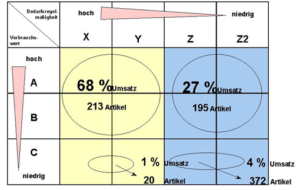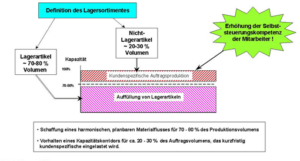by Gerd Däumler1 and Helmut Abels
If you want to gear your production and warehouse to the highest possible readiness for delivery, you should follow the 80/20 rule. At least this is the experience of the Decorations and Specialty Products business unit of dmc² AG, Frankfurt. After capacity planning was changed to a utilization rate of around 80% for stock replenishments and only those items that account for around 80% of sales were stored in the warehouse, the level of delivery readiness was increased to over 98%. At the same time, the value of inventories was reduced by more than DM 2 million.
In recent years, dmc²’s Decorations and Specialty Products business unit has seen a sharp increase in demand for decorative paints, precious metal preparations and organic decorative additives, which are used for high-quality decorations on ceramic substrates (porcelain, bone china, earthenware, enamel) and glass. This was an extremely pleasing development, as the associated high levels of capacity utilization seemed to ensure an optimal cost structure.
However, the high capacity utilization blocked the flexibility to react quickly to important customer requests. To counteract this, special rush orders were introduced, which were to be given priority in production. However, this meant that the number of rush orders increased steadily and production plans had to be constantly revised. In the age of modern PPS systems, this was not a particular problem, but this approach did not lead to the desired result of high delivery readiness, because
- Constant planning changes put production in a permanent state of unrest
- Machine or personnel-related downtimes increase the pressure and inevitably lead to a reduction in delivery readiness with demand-synchronized production and borderline capacity utilization planning
- Production also ran the risk of being increasingly divided into smaller batch sizes due to rush orders, which would lead to an increase in set-up times
To avoid this, stocks in the warehouses for intermediate and end products would have had to be increased if production planning had remained unchanged. However, as stock levels had already reached considerable proportions and further expansion was to be avoided, it was imperative to take a close look at the existing overall concept for planning and controlling order processing. It was necessary to estimate to what extent an optimization of the production throughput time could be realized and to what extent stocks would then be required to ensure delivery readiness.
Abels & Kemmner’s first task was to examine the material flows in the entire logistics chain and to determine the capacity situation in production and the warehouse. The data obtained quickly showed how dmc² could achieve better delivery readiness: The article assortment not only represented the classic 80/20 rule, according to which 20% of articles generate 80% of sales, but also the realization that two thirds (68%) of sales are attributable to a quarter (27%) of the article spectrum, which includes regular and therefore easily plannable articles (see Fig. 1, AB-XY articles). However, this weighting was reflected neither in production nor in the warehouse.
For historical reasons, for example, there were still a disproportionately high number of materials in the warehouse that belonged to the C/C items in the period under review of the last 12 months or that did not show any movement at all. In addition, production was interrupted too often by rush orders, which meant that the throughput time for orders was sometimes up to three times longer than the actual process time required. At the same time, three times as many intermediate products were stored at the plant. The solution to the problem was therefore obvious.

Concept of the new production planning and control system
Today, dmc² plans and controls its production and the associated warehousing and material procurement according to the 80/20 principle, which in this specific case means that products in the AB/XY categories are stockpiled and continuously taken into account in production planning with approx. 70-80% capacity utilization. The remaining items (C/Z items) were largely removed from stock and only ordered and produced as required.

The result of this simple planning approach is enormous: the stock level has been reduced by more than 2 million stock value. This improved both the company’s liquidity and its earnings situation, as the warehousing costs required for these stocks (insurance, warehouse management costs, interest on tied-up capital, etc.) are no longer incurred. On average, series and variant manufacturers such as DMC² assume that this is around 15 to 25 percent of the stock value.
The significantly reduced number of express orders now only affects weekly planning in exceptional cases and machine-related downtimes can be better absorbed. Depending on how incoming orders develop within the planning time frame, later scheduled stock replenishments are brought forward if machine capacities are available. Decision-making authority was largely transferred to the production managers, which led to a significant improvement in self-direction skills and the working atmosphere.
1GerdDäumler is Head of the Decoration and Specialty Products Division at DMC² AG. Since September 10, 2001, the company has belonged to the American Ferro Corp. in Cleveland, Ohio.

